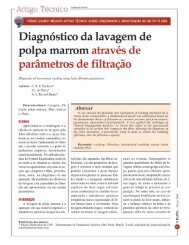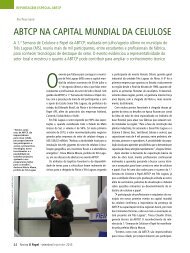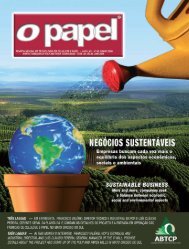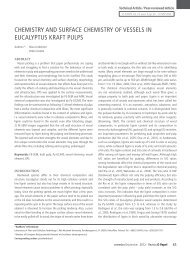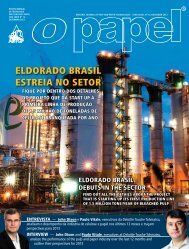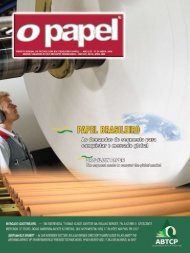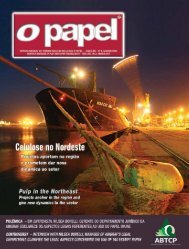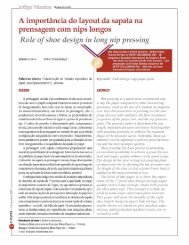Create successful ePaper yourself
Turn your PDF publications into a flip-book with our unique Google optimized e-Paper software.
Technical Article / Peer-reviewed Article<br />
O PAPEL vol. 73, num. 7, pp. 57 - 65 JUL 2012<br />
shortening, Figure 3. At the highest energy input, 20% of the fibres<br />
refined in the H + -form were cut.<br />
At low levels of energy input, the fibres were straightened and an<br />
increase in the shape factor was observed. When the energy input<br />
was increased the shape factor decreased, especially for the pulp in<br />
the Na + - and H + -forms, while no significant decrease was observed<br />
for the pulp refined in the Ca 2+ -form, Figure 4.<br />
Figure 3. The length-weighted fibre length as a function of specific<br />
refining energy input for pulps refined in different ionic forms<br />
No differences in bendability, i.e. fibre flexibility, were<br />
observed between the fibres refined in different ionic forms,<br />
Figure 5. Since the analysis in the FiberMaster is done in tap<br />
water, there is an immediate ion exchange of fibres in the Na + -<br />
or H + -forms to the Ca 2+ -form.<br />
Rheological measurements<br />
The unrefined and refined pulp samples were evaluated in a stress<br />
plate rheometer at three different pulp consistencies. Figure 6 shows<br />
the storage modulus and the critical strain for the different samples.<br />
A higher consistency gave, as expected, a higher storage modulus,<br />
the highest value being obtained for the unrefined pulp samples. At<br />
the lowest consistency - approximately 1.5% - no difference was<br />
observed between the pulp samples regardless of refining energy<br />
or ionic form. At higher pulp consistencies, the storage modulus<br />
decreased with increasing refining. No significant differences were<br />
observed between the different ionic forms, Figure 6a.<br />
The critical strain was not as sensitive to pulp consistency,<br />
but the critical strain increased with increasing refining, Figure<br />
6b. No systematic difference between the different ionic forms<br />
could be observed.<br />
Figure 4. The shape factor as a function of specific refining energy input<br />
for pulps refined in different ionic forms<br />
kW<br />
Figure 5. The bendability - where the shape factor of the fibres was<br />
measured at two different flow rates for the 1.5-3 mm fraction - as a<br />
function of specific refining energy input for pulps refined in different<br />
ionic forms<br />
Figure 6. a) The storage modulus and b) the critical strain as a function of<br />
pulp consistency for pulps refined in different ionic forms and at different<br />
energy inputs<br />
60 <strong>Revista</strong> O <strong>Papel</strong> - julho/July 2012



